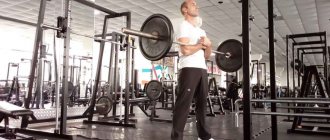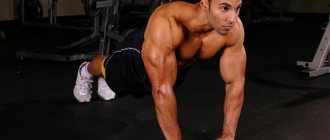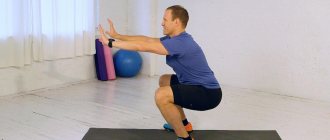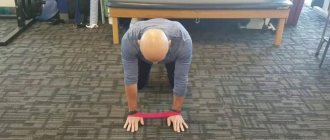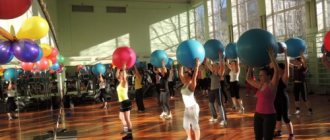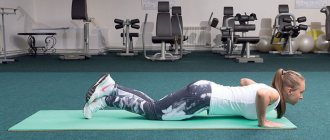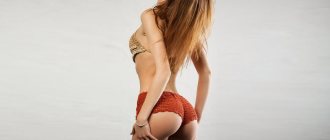Running is one of the easiest and most effective ways to improve your physical fitness. By strengthening and developing your leg muscles, you can not only avoid injuries, but also significantly improve your athletic performance.
If you want to have truly strong legs, thanks to which you can easily carry almost any load, then running training alone will not be enough. Running, despite all its health benefits, is an injury-prone sport, and many runners, regardless of age and level of training, have at one time or another encountered various injuries and injuries.
One of the main benefits of strength training is strengthening the leg muscles that are directly involved during running, which in turn significantly reduces the risk of running injuries.
In addition, well-developed muscles are slower to fatigue and make your running technique more efficient and economical. This means you will need less oxygen to maintain your target pace. Also, doing strength training involves increasing your muscles' ability to produce force.
A scientific review1 of 26 studies published in 2014 in The Journal of Sports Medicine found that strength training improved performance in competitive endurance athletes. Additionally, there are a number of studies that show that this type of training can lead to increased endurance and improved running economy2,3,4.
What muscles are involved during running?
In order to get the most out of your leg workout, you first need to understand which muscles are used when running and how they interact with each other.
Unlike walking, during running there is no double support phase (when both legs touch the ground at the same time), and both legs lift off the surface (flight phase). The faster you run, the longer the flight phase lasts and the shorter the period of contact with the ground.
During initial contact with the surface, the main load is taken by the quadriceps femoris muscle or quadriceps (and especially one of its bundles, the rectus femoris muscle). In addition, the strong contraction of the femoral heads of the quadriceps prevents flexion of the hip at the knee joint during landing. At the same time, the muscles of the lower leg - the soleus and gastrocnemius - also help absorb shock.
To ensure the lifting of the supporting leg, the posterior group of thigh muscles, hip flexors, quadriceps, gastrocnemius and soleus muscles are included in the work, the last two act as a kind of springs.
At the beginning of the flight period, the hip flexor muscles contract: the rectus femoris, sartorius and tensor fasciae lata. When moving the leg forward, the iliopsoas muscle plays an important role.
The hip extensor muscles, primarily the gluteus maximus, are important for runners. At the moment of the push, as well as during the back step of the free leg, this muscle is in a contracted state, while on the other leg it is stretched. The gluteal muscles also stabilize the pelvis and help keep the body upright.
Exercise is bad for your joints
It is a mistake to believe that exercise can harm your knees. You may come to this conclusion because it hurts. But it’s worth remembering that gradually increasing the load trains your joints and makes them more mobile. Studies have shown that those who regularly engage in this type of exercise rarely suffer from arthritis. The same applies to running. People who are over seventy years old and who have been running every morning and evening for at least twenty years do not have osteoarthritis, and they also rarely undergo hip replacement surgery. Therefore, it is worth doing cardio and other workouts. The main thing is moderation and consistency for many years.
The cat in the photo changes the attitude of a woman towards a man - scientists have proven
Doctor, my soul hurts. The doctor's answer helps you find self-love
Concert for plants and other best photos from around the world from June 20 to 27
Squats
This basic exercise is aimed at developing and strengthening the thigh, gluteal and calf muscles.
Starting position: feet shoulder-width apart, back straight, arms bent at the elbows and located along the body, toes slightly turned out.
How to do it: Smoothly move your pelvis back and bend your knees until your thighs are parallel to the floor or slightly lower, and your arms simultaneously rise up to approximately chest level.
Tips: When bending, try to ensure that your knees do not go beyond the level of your feet and avoid lowering deeply, this increases the load on the knee joints.
Feeling pain is an indicator of progress
Some people believe that pain is what confirms progress. The more your joints and muscles hurt when you climb up dozens of stairs after a workout, the better you will feel and the faster your weight loss. In fact, this is not true at all. Giving yourself excessive stress is simply mocking yourself. Your body signals that it is tired and losing its last strength. You don't need to do anything that causes you severe pain. No one has canceled the unpleasant sensations that arise after training out of habit. But making every effort to exceed what was planned is not only pointless, but also harmful. Progress can be made without pain, and you must remember this.
Has hardly changed: Irina Dubtsova showed herself at 13 years old (video)
I wrap cabbage rolls and stick them vertically into mashed potatoes: pie recipe
-100 kg: Maxim Fadeev admitted to his subscribers that his diet bore fruit
Squat Jumps
This exercise primarily develops the quadriceps, hip adductors, gluteal and calf muscles.
Starting position: feet shoulder-width apart, back straight, arms bent at the elbows and located along the body, toes slightly turned out
How to do it: Smoothly move your pelvis back and bend your knees until your thighs are parallel to the floor or slightly lower, then push off with your toes and jump up, while your elbows go back, giving momentum to the jump. When you land, lower yourself back into a squat and repeat the movement.
Tips: Try to avoid landing on your straight legs and heels.
Stepping onto a platform with a hip lift
In this exercise, the main load falls on the quadriceps, hamstrings and gluteal muscles of the thigh.
Starting position: Select a platform (bench, drawer or cabinet) and place your left foot on it fully. It is advisable to choose a height so that the thigh is parallel to the floor when walking (the angle at the knee is 90 degrees). The arms are bent at the elbows and brought together in front of you at chest level.
How to do it: Leaning on your left leg, begin the ascent by straightening your supporting leg at the knee. When your leg is fully straightened, continue the movement with your right leg, bringing your thigh in front of you until it is parallel to the floor. Hold this position for 1-2 seconds, and, bending your left leg at the knee, smoothly place your right leg back on the floor.
Hand movement. During the lifting phase, extend your arms so that at the top point they are straight and positioned at your sides, while lowering, return them to their original position.
Adviсe:
- To better load your muscles, perform exercises on one leg first, then the other, rather than alternately.
- Try to keep your back straight.
Change yourself: squats instead of running
Author Peter Deryabin
Updated: 12/21/2019 03:25 Published: 02/25/2004 08:31
Health » Beauty » Fitness
Today, experts offer new approaches to physical education. What is their essence? Answered by Sergei Mikhailovich BUBNOVSKY, candidate of medical sciences, head of the Moscow Center for Kinesitherapy in Sokolniki.
“Our 600 muscles, 400 joints and several kilometers of tendons require their “breakfast, lunch and dinner” in the form of regular training every day. Everyone needs physical education.
— Even with chronic illnesses, when is physical activity contraindicated for a woman?
— None of the diseases excludes physical education. If only a simple rule is followed - correct movement heals, and incorrect movement cripples. This, by the way, is the basic principle of kinesitherapy - the science of healing with movement. But it is no secret that we lack physical education as such, and almost all of us train our bodies incorrectly. And few people know that the only tissue that can recover at any age is muscle. But on one condition. When we force it to contract and relax. If a muscle does not work, then it will never restore its functions, and the pain will not go away. The grossest and most common mistake is to go to the mirror one day, look at yourself and your cellulite and suddenly start running in the morning, doing aerobics and other haphazard gymnastics.
— But why?
- The answer is simple. The worst load is the weight of your own body, which an unprepared muscular system cannot cope with. As a result, pain in the back and joints, salt deposits, gout and arthrosis appear. With a properly selected training program on special simulators, there is no load. We locally influence each muscle and each joint, gradually restoring the body to normal. Any woman needs such preparation. Healthy - before you start regularly doing step, aerobics or tennis. And for a woman with a diagnosis - in order to overcome pain, fear, and sometimes the disease itself.
— What can you cure in the gym?
— With a properly selected training program, including not only gymnastics, but also cryotherapy, various forms of massage, a sauna according to the rules of a Russian bath, people get rid of crutches, corsets, asthma attacks, drug addiction, and hypertension. And most importantly, the fear of any physical activity disappears, regardless of age.
— What if you arm yourself with some set of exercises, for example, for osteochondrosis, and just do it at home?
- Is it dangerous. You can turn your neck or bend over so much that you can’t straighten up. And it would be nice to first understand the true causes of your pain. After all, osteochondrosis is actually not a disease, but a consequence. When there is not just a “crunch” in the neck or lower back, but the cartilage and joints are actually affected. This is visible on x-rays, and a similar process is observed after sixty years, not earlier. The main task here is to relieve the load from the affected articular surfaces, so that only the muscles work, but not the diseased joint. And this can only be done on special simulators.
— But even a thirty-year-old woman can experience pain in the neck and shoulders.
— She has pain, but does not have osteochondrosis. Because her problems are related to the condition of her muscles and ligaments. Pain is an alarm signal. It just needs to be decrypted correctly. And do not try to recover on your own, even with the help of the best gymnastics. At the first stage, only a professional can help. Take, for example, another female problem - cellulite. No ointments or massage will give a lasting effect without the right exercises. Exactly the right ones. Because most of the exercises you do at home target the front of your thighs. And all these “orange peels” are located mainly on the sides and behind. And precisely because the least-working muscle group is located there. Make them work evenly and cellulite will go away.
— What if instead of going to the gym you go to the pool?
— To benefit from the pool, you need to swim long, technically and quickly. If you swim less than 800 meters in a row, you came to the pool in vain. Or if you swim 800 meters in 25 minutes, then this is also just swimming. But in order to swim quickly and technically, you must again have well-trained and restored muscles. That is, undergo basic general physical training.
— Still, it remains unclear how classes can be recommended, for example, for women with high blood pressure?
— Skeletal muscles are often called the second heart. If we load it correctly, then we give rest to the real heart. And this even helps treat hypertension. Physical education is a good assistant in the treatment of purely female ailments. If you force the pelvic muscles to work evenly, you can get rid of congestion and the disease itself. Kinesitherapy removes the fear of pain, the fear of the doom of the disease and teaches a person to control his body so that his quality of life improves. Only movement can lift you out of severe depression associated with illness.
— How do you feel about this type of physical activity like jogging?
— Morning jogging benefits only those who have good running technique, whose muscles are in perfect order, and who do not forget to do a couple of special exercises before and after jogging. Everyone else runs the risk of developing lumbar osteochondrosis and arthrosis of the knee joints. Running is a thousand blows to the joints. Only prepared muscles and ligaments can protect them.
— And how to do this?
— Before going outside, you need to relieve nighttime stiffness with a cold shower, but not a contrast shower, because contrast relaxes. Actively rub and prepare the muscles of the spine and ligaments of large joints. The following exercises are recommended for women: 1. Lying on the floor on your back, putting your hands to your ears, while exhaling, pull your knees to your elbows 15-20 times.2. On the horizontal bar or wall bars, raise your legs to a corner or pull your knees to your chest. Up to 20 times.3. A handheld exercise machine, a roller with two handles, will also come in handy. He is rolled on the floor, kneeling and holding the exercise machine in outstretched arms. As you inhale, you stretch out, and as you exhale, you return to the starting position. The back should be arched upward as much as possible. Repeat at least 15 times.4. Good exercises with an elastic rubber bandage. It can be stretched with your hands, feet, lying on the floor or sitting on a chair. After running, you need to perform 2-3 exercises that relieve the load on the spine. Work out on the horizontal bar, raising your knees to your chin as you exhale. After which you can take a contrast shower, finishing it with a cold douche. And you shouldn’t forget about the right shoes for running. Saving on quality running shoes can later lead to gout or arthrosis. As you can see, running is by no means an easy task.
— Maybe there is another way to gain energy, cheerfulness, lightness?
— Jogging can be replaced with squats, and not deep ones, up to knee level. Without lifting your heels, you need to squat down so that your thigh line is parallel to the floor. One hundred of these squats will replace you with a kilometer of treadmill. Start with 10-20, and in six months you will be able to squat 500 times. And one more important tip. To protect your body from stress, you need to prepare it for the coming day. Do 2-3 stretching exercises for breakfast, several bends and turns for lunch, and for dinner offer it gymnastics that strengthens the abs and at the same time relaxes the spine. Believe me, it will be very grateful to you for this. 100 squats replace a kilometer of running. Muscle tissue is the only one that can recover to normal at any age.
Topics: asthma, arthrosis, cellulite, hypertension, spine, osteochondrosis, drug addiction treatment
Discuss
Explosive Platform Steps with Hip Raise
This exercise develops explosive strength and power in the leg muscles.
Starting position: Select a platform (bench, drawer or cabinet) and place your left foot on it fully. It is advisable to choose a height so that the thigh is parallel to the floor when walking (the angle at the knee is 90 degrees). The arms are bent at the elbows and brought together in front of you at chest level.
How to do it: To give inertia to the body, lightly push off the floor with your right foot and perform a sharp rise, straightening your supporting leg at the knee. When your left leg is fully extended, take a small jump up and continue the movement with your right leg, bringing your thigh in front of you until it is parallel to the floor. Then, bending your left leg at the knee, smoothly lower your right leg back to the floor and repeat the movement.
Adviсe:
- Make sure the platform remains stable even when jumping. To better load your muscles, perform exercises on one leg first, then the other, rather than alternately
- Try to keep your back straight.
Less rest - more progress
You should not think that you should work on yourself until you are completely exhausted. If you train without rest, you will be able to do a lot more exercises, but they will be of lower quality. In addition, your reserve of strength will not last long, since over time you will weaken and your pace will slow down. So, if you worked efficiently for half an hour and an hour, and then rested, the effect would be much better than training for several hours without rest. This can be compared to a real mockery of your body. Therefore, you need to feel sorry for yourself in moderation and not do anything that is excessive.
Learning to tolerate imperfection is part of a self-improvement project.
Selena Gomez, Tom Hanks: why do stars focus so much on Freedom Day?
Not only tasty, but also very healthy: prepare strawberry-ginger lemonade
Split squats
The exercise involves the quadriceps, hamstrings, and gluteal muscles.
Starting position: Stand straight, take a wide step back, and place the toe of your abducted foot on the platform (box, bench or cabinet).
How to do it: Keeping your back straight, bend your supporting leg at the knee until your thigh is parallel to the floor, the knee of the abducted leg goes down, then smoothly straighten your leg and repeat the movement.
Adviсe:
- make sure that the knee of the supporting leg does not go beyond the level of the foot
- To increase the load on your muscles, you can hold a dumbbell in each hand.
Explosive Split Squats
This exercise develops explosive strength and power in the leg muscles.
Starting position: Stand straight and take a wide step back, the toe of your abducted leg is on the platform, your arms are bent at the elbows at chest level and placed in front of you.
How to do it: Keeping your back straight, bend your supporting leg at the knee until your thigh is parallel to the floor, while the knee of the abducted leg goes down. At the bottom, push off slightly from the floor, make a small jump up and land smoothly on your full foot. The arms go back during the jump, giving the body inertia.
Tips: the supporting leg does not fully straighten at the top point, this reduces the load on the knee joint.
How to run correctly to pump up your legs
To pump up your legs while running, you need
:
- Start running
from short distances on level ground, since if you immediately load your legs by running up any hill or do it for a long time without rest, you can get a serious injury. - Find
the technique that will be convenient for your physical fitness. - Depending on the chosen technique, follow the rules
of foot placement when running. Let's say that when running a long distance you need to put your foot on your full foot or roll from heel to toe, and in short races at speed you need to run on your toes. - It is also important to choose
the right, comfortable shoes that will not cause discomfort while jogging. - Before each race you need to do a warm-up
, and after it -
stretching
. This will help not injure your legs, as well as get rid of discomfort the next day after training. Starting to run without warming up puts a lot of stress on your heart.
A few tips to help you run more efficiently
:
- Always have water with you to replenish lost energy.
- Gradually increase the load and start running with weights or quickly climb the stairs.
- Having reached maximum speed, it will be enough to make several small runs to a hill every day.
- Make a plan that will help evenly distribute the load on the body.
- During long runs, in order not to lose your breath, run at the same pace throughout the entire time.
- To achieve a better result, you can try using various obstacles or running for a while on straight legs, squatting, with a high hip lift.
- Don’t forget that if you have little fat mass, you won’t be able to gain a lot of muscle mass.
- After the race, you should not stop immediately. It would be best to gradually lose speed and then switch to a walk.
Special attention is paid to nutrition
for a person involved in this sport.
Both people who work out in the gym and those who prefer running need a high protein
. It will promote muscle growth.
To feel good, you should not eat before the race. But the water
on the contrary, it should be consumed before, after and during training.
So, a person who wants to pump up their legs through running needs to put in a little more effort than someone who just wants to strengthen or tighten them. But nevertheless, it is possible. The main thing is not to exhaust yourself, and it is also worth consulting with someone who is doing similar things. He can advise and help you run so as not to damage your health. In addition, do not forget that if the load is too intense, the opposite, undesirable effect may occur.
You also need to remember not only how your legs move, but also the position of your back
,
stomach
,
arms
. A straight back and tense abs will help you maintain balance and slow down the feeling of fatigue in your body. And the arms bent at the elbows, which move relative to the opposite legs, make it possible to accelerate.
Over one year old
Regular walks are your chance to get a slim figure. Without a fitness card, complex workouts and expensive additional equipment.
For every person, it is as commonplace as eating or sleeping. It’s so simple that we don’t consider it a fitness workout... And yet walking can solve the problem of physical inactivity of a typical city dweller and make each of us a little slimmer and healthier. “During walking, lung ventilation and blood circulation increase, oxygen saturation of tissues improves, and the heart and blood vessels are strengthened,” says SVETLANA VEPRINTSEVA, leading personal trainer at the TERRASPORT Copernicus fitness center. — Due to the contraction of the calf muscles, blood stagnation in the veins of the lower leg is reduced. This training is useful for women with a predisposition to varicose veins.
.
Additionally, walking at a moderate to brisk pace has been shown to strengthen bones and joints, protecting against osteoporosis
.” This type of fitness is the most accessible of all, it is the easiest way to overcome laziness and start moving in order to adapt to training and prepare the muscles and ligamentous apparatus, as well as the cardiovascular and respiratory systems for more serious loads, in particular for running.
Squatting on a stand on one leg
This exercise primarily targets the quadriceps and hamstrings.
Starting position: Select a platform (bench, box or cabinet) of the required height and stand with your back to it, arms bent at the elbows and brought together in front of you at chest level, your right leg raised in front of you by 15-30 cm.
How to do it: Maintaining balance, move your pelvis back and smoothly lower yourself onto the stand, without the raised leg touching the floor. Pause for 1-2 seconds, then, tensing your thigh muscles and extending your supporting leg, lift up.
Tips: Try to keep your raised leg stationary.
LiveInternetLiveInternet
Is it possible to increase the size of the buttocks while walking? How to increase the size of the buttocks
Physical education and sports activities are good for human health. Jogging strengthens the cardiovascular system, helps increase lung capacity, restores metabolic processes, and therefore helps to get rid of excess weight. Running is indispensable if the goal is to create a beautiful contour of the buttocks, thighs and legs. By running, it is completely possible to pump up your legs to the same extent as with the help of languid strength exercises.
how to increase the volume of flat buttocks how to increase the volume of buttocks
In sports, there are several types of running, differing not only in the length of the distance and the amount of load, but also in the different effects on the general and physical condition of the student.
effective exercise to grow buttocks photo
7 out of 10 people are infected with parasites to varying degrees of severity. Many live and suffer for years, leading an incomplete life and depriving themselves of pleasures, and do not even suspect that they are breeding within themselves these terrible worms and larvae that destroy internal organs. The usual remedy will help get rid of parasites - you just need to drink it on an empty stomach. Press. »
how to grow buttocks through nutrition
A small race involves moving at high and medium speed for 500-1000 m. Such a load has a general strengthening effect on the entire body, plays the role of cardio training, increases the metabolic activity of the body, and at the same time the leg muscles and buttocks become more elastic.
shaping underwear for butt growth
- lifting straight, bent, crossed legs from a lying position, etc.
- reducing the body's immune defense
- weighted squats;
- moving the leg bent at the knee from a kneeling position;
- moving the leg to the side and back from a kneeling position;
- moving the leg to the side and back from a kneeling position with a fixed weight;
- inclined movements backward from a cross-legged position;
- With regular jogging, you can gradually increase the load and perform additional movements.
- Before a running workout, you must do a 10-minute warm-up to prepare different body systems for stress, including warming up and stretching the quadriceps and thigh muscles;
- during running training, it is necessary to alternate the load with rest and muscle relaxation, exercises to restore breathing, and light self-massage;
- After a running workout, it is useful to have a relaxing massage or a thermotherapy session;
- During active running training, it is useful to take vitamin complexes.
increasing the buttocks life restrictions
Sprinting is running short distances at high speed, which is one of the most active activities that helps burn calories in the body and normalize body weight, as well as acquire elasticity of the tendons and muscle tissue on the calves, thighs, and buttocks. These processes occur not only during physical activity, but also after it, and do not require the purchase of special equipment, visiting expensive gyms, the help of a trainer, working with weights on the legs - you just need to run in the fresh air, enjoying it.
how a man can enlarge his buttocks how to enlarge his buttocks with plastic surgery
Standard sprint training for a non-professional athlete consists of 6-10 cycles of 100-meter running distances.
IT IS IMPORTANT TO KNOW! Having trouble gaining weight normally? So you just need to remove it from the body. Read more>>>
buttocks thigh enhancement exercises
Usually, during the first training sessions, it is worth choosing a speed of movement that is intuitively assessed by the practitioner as a half-hearted movement.
butt enhancement pills
For beginners, it is better to start running workouts at 50% speed, and then gradually increase your speed after each workout.
After the hundred-meter race, it is correct not to stop, but to return to the starting position with a leisurely step or a light jog, which will have a relaxing effect on the muscle mass and the entire body in general (breathing and heart rate are normalized, the blood is saturated with oxygen, mental and sensory relaxation, etc. ).
increasing the size of the buttocks without surgery
In order for metabolic processes to proceed fully, clothing is selected from cotton knitted fabrics that do not interfere with the release of sweat. The idea that the best effect is produced by synthetic sportswear, which clogs the body and does not allow the skin to promptly get rid of decay products and metabolic products, is erroneous.
plastic buttock enhancement
If necessary, you can increase the rest time by a couple of minutes, once you are back at the start, but it would be incorrect to completely finish the movement (sit down, lie down, etc.) - it is important to continue it, even very slowly.
transgender buttock enhancement
At the end of the training process, it is necessary to switch from running to race walking, because the body needs to cool down, and this process should not be forced; it is most likely to move from a state of high activity to rest evenly.
increase the volume of the buttocks once a day
Running workouts make it possible to pump up your legs and gluteal muscles. but immediately a significant load is applied to the abs and other muscle groups, which helps to make the whole body perfect. This effect is a consequence of the elementary leg raises of a running person at the knees: covering a hundred-meter distance, a professional performs about 50 leg lifts, and a non-professional - about 60. Repeating six times will have a better effect, even compared to squats and various types of leg lifts with weights, and the load despite all this, it is not felt either psychologically or physically.
buttock enlargement without surgery
Modeling of the gluteal muscles occurs successfully in the process of acceleration, going uphill or up stairs, with lifting or overlapping the hips, also with the help of a treadmill, which allows you to set the running mode to an incline.
unsuccessful buttock augmentation surgery
how much does it cost to enlarge buttocks
Forming a pumped up gluteal muscle will be effective if you add special exercises to running:
program about buttock enlargement
The treadmill of the exercise machine provides an even load on all muscles and promotes the formation of correct posture; With all this, you can exercise in the gym or at home.
Elena Mashysheva, TV presenter, nutritionist: “How easy it is to cleanse the body and gain muscle mass . A proven method is to write down the recipe. "
increase buttocks exercises
More complex, but also much more effective are types of running such as high-speed climbing up a hill or along a set of stairs.
how to enlarge buttocks and thighs at home
In this case, the correct dosage is limited to five ascents combined with smooth descents. Using this type of running activity, which involves sharp contractile muscle movements, we pump the extensor muscles, gastrocnemius, soleus and muscles near the fibula.
how can you enlarge your buttocks buttock enhancement surgery wtys buttocks enlargement with products
The famous jogging, despite its apparent unathleticism and accessibility even for elderly people, also helps make the leg muscles elastic, sculpted and strong. The duration of the workout should be about half an hour, the movements should be feasible, but not accompanied by stops.
Brazilian butt enlargement
In order not to harm the body and avoid injury to muscle tissue, so as not to pump up your legs to the detriment of your health, you should follow important rules while running:
buttock enhancement without surgery free of charge
gymnastics to increase the muscles of the buttocks
For training, you need to choose a special uniform and shoes designed for this type of running. Proper functioning of the leg muscles is ensured by shoes that fit the feet with thick elastic soles.
how to enlarge a woman's buttocks
how to pump up your buttocks and enlarge your hips, buttock thigh enlargement exercises video
Scientists have found that running training tightens leg muscles more effectively than training in gyms, thanks to the emotional background that forms in a person who runs in the fresh air, surrounded by the sounds and colors of nature.
enlargement of legs and buttocks prices
Running is beneficial at any age for the male and female body. Excellent results in the formation of powerful, elongated muscles are noted by bodybuilding and fitness experts. It will not be difficult to pump up your legs by running, and at the same time this activity indirectly affects the joints and muscles of the upper half of the body.
buttock enlargement photo
- Kim Kardashian has grown her buttocks
- weight loss
- frequent fatigue
- depression
- headaches, as well as various pains and spasms in the internal organs
If you feel like you can't gain weight, you just need to cleanse your body .
Read how to do it here >> how to increase the size of your buttocks without surgery Probably every girl has thought about whether it is possible to pump up her legs by running. Physical education and sports activities are beneficial for human health. Jogging strengthens the cardiovascular system, increases lung capacity, normalizes metabolic processes, and therefore helps to get rid of excess weight.
One leg squat
This exercise develops coordination and dexterity, the main load falls on the quadriceps, hamstrings and adductor muscles of the thigh, the gluteal muscles are used to a lesser extent.
Starting position: Back straight, arms bent at the elbows and brought together in front of you at chest level, right leg raised in front of you by 20-30 cm.
How to do it: While maintaining balance, smoothly move your pelvis back and perform a squat. Lower yourself down until your thigh is parallel to the floor or slightly lower. Then, tensing your thigh muscles and extending your supporting leg, lift up.
Adviсe:
- Try to keep your back as straight as possible
- if you have problems with your knees, then it is better to avoid this exercise
Libra is meaningless
Some gurus will argue that weighing is a completely useless exercise. As you lose water, your weight decreases, and as you gain muscle mass, it increases. Therefore, focusing on indicators does not make sense.
It turns out that owls sleep like people - on their stomachs: 10 funny photos
It's not about nutrition: the nutritionist named the factors influencing the presence of excess weight
Private terminal in New York looks more like a ski chalet than an airport (photo)
In fact, the number of kilograms can really depend on many factors. There are certain days when your scales will make you happy, and there are also those when they will make you sad. But you should not ignore them, since weight control is still necessary for progress, since it is indicative. If you dream of losing weight, you need to see the dynamics on the scales, because you can’t do without it (volumes definitely go away with kilograms). You just have to remember that fat loss will happen much faster than the rate of muscle gain.
Lunges forward
This exercise uses almost all the thigh muscles and gluteal muscles.
Starting position: feet shoulder-width apart, back straight, arms at your sides.
How to do it: take a wide step forward with your left leg so that the thigh of your left leg is parallel to the floor, while the knee of your right leg should barely touch the floor. Tightening your gluteal and hamstring muscles, take a step back and return to the starting position.
Adviсe:
- Try to maintain a straight body position and make sure that the knee does not go beyond the level of the toe
- To make the exercise more difficult, you can hold dumbbells in both hands.
Get off on the wrong foot
If you get out of bed with your left foot, you will be angry all day.
The left leg is connected to the right hemisphere of the brain, which is responsible for rational thinking. And a successful day happens only when you use not only reason, but also intuition in life. Only when these two of your abilities work simultaneously will everything work out as it should. And if everything doesn’t go the way you would like all day long, then how can you not be angry? That’s why they say that in order for the whole day to be successful, you must definitely get up on the right foot. Not used to it? If you want everything to be fine, accustom yourself to this simple rule - watch which foot you get out of bed in the morning.
Jumping lunges
This exercise develops explosive strength and power in the leg muscles.
Starting position: feet shoulder-width apart, back straight, arms bent at the elbows and brought together in front of you at chest level.
How to do it: take a wide step forward with your left leg so that the thigh of your left leg is parallel to the floor, while the knee of your right leg should barely touch the floor. In the bottom position, push off with your feet on the floor, jump and switch legs. Repeat the movement on the other side. The arms go back during the jump, which gives the body inertia.
Adviсe:
- avoid landing on your heel
- try to maintain a straight back position
Side Lunges
This exercise primarily engages the gluteal muscles, quadriceps, and hip adductors.
Starting position: legs together, back straight, arms bent at the elbows and brought together in front of you at chest level.
How to do it: Take a wide step to the right side, shifting your weight to your right leg, and bend your knee until your thigh is parallel to the floor, keeping your left leg fully straight. Accelerate your leg, return to the starting position, and repeat the movement.
Tips: try to ensure that the knee of the supporting leg does not go beyond the level of the toe.
Exercise machines are your worst enemy.
Some people believe that exercise machines are soulless machines that can cause them harm. They force you into awkward linear movements and take away natural movement. In part, this is true, but very relative. When approached from a professional's perspective, these machines can work wonders. They can involve less adjustment, allow you to work harder, and provide additional stimulation to isolated muscle groups. The main thing is that you have a good instructor nearby or that you are competent in these matters. But, by the way, the leg press will not replace your natural squatting.
Lunges with 180 degree rotation
This exercise additionally engages the abdominal muscles and improves coordination.
Starting position: legs together, back straight, arms bent at the elbows and brought together in front of you at chest level.
How to do it: Turn your body 180 degrees and take a wide step forward with your left leg so that the thigh of your left leg is parallel to the floor, while your right knee should barely touch the floor. As you rotate your torso in the opposite direction, take a step back and return to the starting position, then repeat the same movement on the other side.
Tips: try to ensure that the knee of the supporting leg does not go beyond the level of the toe.
Bend the torso forward while standing
This exercise strengthens the back extensors, gluteal muscles and hamstrings.
Starting position: feet shoulder-width apart, back straight, arms bent at the elbows and brought together in front of you at chest level.
How to do it: Moving your pelvis back, tilt your torso until it is parallel to the floor, if necessary, slightly bend your knees, but be sure to keep your back straight. At the lowest point, the gaze is directed forward, the neck and spine form one line. When extending, tense the muscles of the lower back and back of the thigh.
Tips: do not round your back, try to maintain a natural arch in your lower back.
Muscles that work when running
Running allows you to work all muscle groups , although the main load is on your legs. The heart muscle, abdominal muscles and neck also work. So, the muscles working in this sport can be divided into several types :
- Leg muscles Quadriceps . Located on the front of the thigh above the knee joint, they are responsible for its movement when running. It is one of the largest muscles.
- Biceps muscles . Located on the back of the thigh, just below the buttocks. They work by bending the knee and raising the leg.
- Gluteal muscles . They are responsible for fixing the torso and also act when turning the hip. They are considered one of the strongest human muscles.
- Calf muscles . Active when running. Helps a person maintain balance.
- Posterior tibialis . Located under the calf muscle. Maintain balance and participate in rotation and flexion of the foot.
- Latissimus dorsi muscles . Occupies the lower back. They work by moving the arms back.
Bend your torso forward while standing on one leg
This exercise additionally engages the abdominal muscles and improves coordination.
Starting position: legs together, back straight, arms at your sides.
How to do it: While maintaining balance, bend forward while lifting your right leg up. At the lowest point, the torso and raised leg should be parallel to the floor, while the arms are straightened and lightly touch the floor. Tightening the muscles of your thighs and buttocks, lift your body, lower your leg back and return to the starting position.
Tips: If you lack flexibility, you can slightly bend your supporting leg at the knee.
Jumping onto the platform
This exercise uses almost all the muscles in your legs and develops explosive power.
Starting position: select a platform (box, cabinet, bench) of the required height and stand in front of it. Feet shoulder-width apart, back straight, arms at your sides.
How to do it: Move your arms back slightly to give your body a little momentum, bend your knees and jump onto the platform. When landing, further lower your hips, this will allow you to better load the muscles, then carefully step off the platform and repeat the movement.
Tips: Try not to land with your legs straight or on your heel, this will reduce the impact on your knees.
Is it possible to pump up your legs by running?
With the help of running, you can pump up and strengthen your leg muscles, since they are well used in this sport. Using different techniques and gradually increasing the load, it is possible to lose a few extra pounds, while muscle mass will grow.
When running long distances , you will not be able to acquire too defined muscles, since the legs become more durable and more accurate than those that can often be seen in people who work out professionally in the gym.
Many people have probably heard that running often leads to a decrease in muscle mass . This happens due to the fact that after running a long distance, the body needs more energy and it finds it in the muscles, from where it takes it.
Therefore, in order not to lose muscle mass, many athletes train by sprinting . This is one of the specific techniques that involve running short distances, and also when using weights, there will be a noticeable increase in the legs, as a result of the transformation of fat into muscle.
So, if a person engages in this type of sport correctly, gradually increasing the load and without injuring his body, then he has the opportunity to quickly see the expected results . Running uses all the leg muscles and that is why it is one of the best ways to work them out, strengthen them and pump them up evenly.
Jumping onto a platform on one leg
This exercise is a more complex modification of the previous one and allows you to improve coordination and dexterity.
Starting position: select a platform (box, cabinet, bench) of the required height and stand in front of it. Raise your right leg 10-15 cm.
How to do it: move your arms back slightly to give your body a little momentum, bend your supporting leg at the knee and jump onto the platform. When landing, further lower your hip down, this will allow you to better load the muscles, then carefully step off the platform and repeat the movement.
Tips: Try not to land with your leg straight or on your heel, this will reduce the impact load on the knee joint.
Jumping with knees to chest
This exercise uses almost all the muscles of the legs, as well as the abdominal muscles, and develops explosive strength.
Starting position: feet shoulder-width apart, back straight, arms raised in front of you at shoulder level.
How to do it: with a sharp movement, jump up as high as possible, while trying to pull your knees as close to your chest as possible. During the jump, your arms are extended in front of you at shoulder level.
Advice:
- try to land with slightly bent legs, this will reduce the impact on your knees
- avoid landing on your heel
